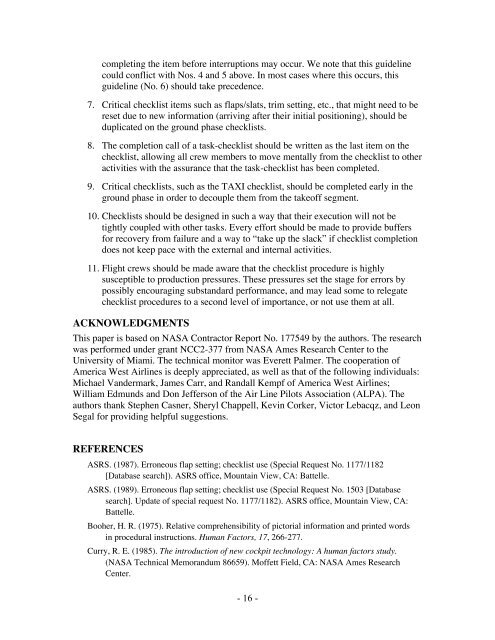COCKPIT CHECKLISTS: CONCEPTS, DESIGN, AND USE - NASA
COCKPIT CHECKLISTS: CONCEPTS, DESIGN, AND USE - NASA
COCKPIT CHECKLISTS: CONCEPTS, DESIGN, AND USE - NASA
You also want an ePaper? Increase the reach of your titles
YUMPU automatically turns print PDFs into web optimized ePapers that Google loves.
completing the item before interruptions may occur. We note that this guidelinecould conflict with Nos. 4 and 5 above. In most cases where this occurs, thisguideline (No. 6) should take precedence.7. Critical checklist items such as flaps/slats, trim setting, etc., that might need to bereset due to new information (arriving after their initial positioning), should beduplicated on the ground phase checklists.8. The completion call of a task-checklist should be written as the last item on thechecklist, allowing all crew members to move mentally from the checklist to otheractivities with the assurance that the task-checklist has been completed.9. Critical checklists, such as the TAXI checklist, should be completed early in theground phase in order to decouple them from the takeoff segment.10. Checklists should be designed in such a way that their execution will not betightly coupled with other tasks. Every effort should be made to provide buffersfor recovery from failure and a way to “take up the slack” if checklist completiondoes not keep pace with the external and internal activities.11. Flight crews should be made aware that the checklist procedure is highlysusceptible to production pressures. These pressures set the stage for errors bypossibly encouraging substandard performance, and may lead some to relegatechecklist procedures to a second level of importance, or not use them at all.ACKNOWLEDGMENTSThis paper is based on <strong>NASA</strong> Contractor Report No. 177549 by the authors. The researchwas performed under grant NCC2-377 from <strong>NASA</strong> Ames Research Center to theUniversity of Miami. The technical monitor was Everett Palmer. The cooperation ofAmerica West Airlines is deeply appreciated, as well as that of the following individuals:Michael Vandermark, James Carr, and Randall Kempf of America West Airlines;William Edmunds and Don Jefferson of the Air Line Pilots Association (ALPA). Theauthors thank Stephen Casner, Sheryl Chappell, Kevin Corker, Victor Lebacqz, and LeonSegal for providing helpful suggestions.REFERENCESASRS. (1987). Erroneous flap setting; checklist use (Special Request No. 1177/1182[Database search]). ASRS office, Mountain View, CA: Battelle.ASRS. (1989). Erroneous flap setting; checklist use (Special Request No. 1503 [Databasesearch]. Update of special request No. 1177/1182). ASRS office, Mountain View, CA:Battelle.Booher, H. R. (1975). Relative comprehensibility of pictorial information and printed wordsin procedural instructions. Human Factors, 17, 266-277.Curry, R. E. (1985). The introduction of new cockpit technology: A human factors study.(<strong>NASA</strong> Technical Memorandum 86659). Moffett Field, CA: <strong>NASA</strong> Ames ResearchCenter.- 16 -
















